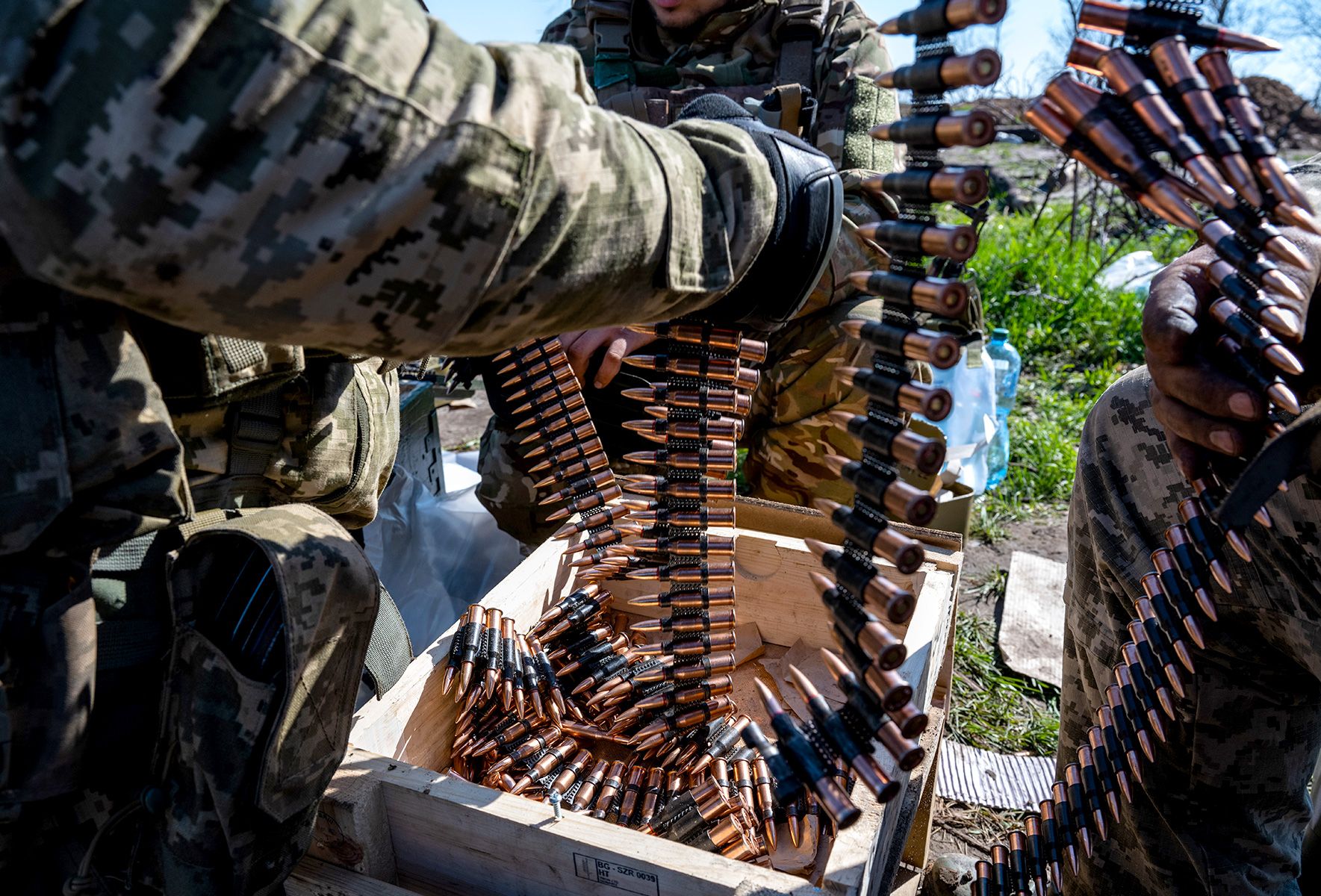Why Ukraine's Burning Through Ammo in War With Russia
Russian and Ukrainian military forces are firing tens of thousands of ammunition shells daily, requiring increased production from Ukraine-backed NATO allies as a counteroffensive remains ongoing.
Ukraine was invaded by Russian forces on February 24, 2022, leading to hundreds of thousands of reported casualties. Between January 24, 2022, and May 31, 2023, the U.S. sent approximately $76.8 billion to Ukraine in humanitarian, financial and security assistance, according to the Council on Foreign Relations.
About $46.6 billion, or 61 percent of that total, has gone towards weapons, equipment, ammunition, training, and grants and loans for more supplies. While 47 countries have provided some form of aid to Ukraine, the U.S. outspends them all by tens of billions of dollars—especially as it relates to military assistance.
Ukrainian soldiers from the 28th Brigade put bullets into clips for use with light machine guns, as Ukrainian Armed Forces units train for a critical and imminent spring counteroffensive against Russian troops, which invaded 14 months earlier, in the Donbas region, Ukraine, on April 26, 2023. Dwindling ammunition stockpiles have affected NATO nations and, in turn, the Ukrainian military aided by them. Scott Peterson/Getty Images
It was estimated earlier this year that Ukraine fires as many 155-millimeter artillery rounds in about five days as the U.S. produces in a month, but that is likely a low estimate according to Guy McCardle, managing editor of Special Operations Forces Report (SOFREP).
"By most accounts, Russia is firing at least four times as many artillery shells as Ukraine," McCardle told Newsweek via email. "That's significant. 20,000 rounds per day for Russia is a low estimate, as is 5,000 rounds per day for Ukraine."
Artillery is the biggest killer on both sides of the war, he added, projecting it causes about 80 percent of all casualties overall in this ongoing war. The high rates of artillery rounds being used seemingly without effort is because "they are effective."
The U.S. State Department provided a breakdown last week of U.S. assistance, including:
Over 2,000 Stinger anti-aircraft systems.
Over 10,000 Javelin anti-armor systems.
Over 70,000 anti-armor systems and munitions besides Stingers and Javelins.
198 155-millimeter howitzers and over 2,000,000 155-millimeter artillery rounds.
Over 7,000 precision-guided 155-millimeter artillery rounds.
Over 14,000 155-millimeter rounds of Remote Anti-Armor Mine (RAAM) Systems.
100,000 rounds of 125-millimeter tank ammunition.
10,000 203-millimeter artillery rounds.
Over 50,000 152-millimeter artillery rounds.
Asked if some U.S.-provided ammunition is being sold by Ukrainians on the black market, Pentagon spokesperson Lieutenant Colonel Garron Garn rejected that theory.
"The security assistance provided by the U.S. and our partners and allies is helping Ukraine defend its sovereign territory from Russian aggression," Garn told Newsweek via email. "As [Defense] Secretary [Lloyd] Austin and many other senior officials have said, there has been no credible evidence of the illicit diversion of weapons and material destined for Ukraine."
Future security assistance could hinder based on U.S. elections and congressional control. While House Speaker Kevin McCarthy has denounced Russia's invasion, he has also said he doesn't "support a blank check."
Current and former military personnel and political officials worldwide have brought attention to the issue of low stockpiles since last year, prompting allies not only to beef up their manufacturing efforts but also their defense spending as the war is projected to cost Russia alone more than $1 trillion as no end remains in sight.
In March, U.S. Army Undersecretary Gabe Camarillo announced that the Army will boost production of 155-millimeter artillery shells more than sixfold, to 85,000 a month by fiscal year 2028, costing about $1.45 billion to increase capacity "to expand 155-millimeter artillery production from 14,000 a month to over 24,000 later this year," and 85,000 in five years, according to Defense News.
The U.S. Army's Joint Munitions Command (JMC) manages domestic ammunition plants for speed of war readiness. Ammo is produced at the following locations:
Crane Army Ammunition Activity, Crane, Indiana
Holston Army Ammunition Plant, Kingsport, Tennessee
Iowa Army Ammunition Plant, Middletown, Iowa
Lake City Army Ammunition Plant, Independence, Missouri
McAlester Army Ammunition Plant, McAlester, Oklahoma
Pine Bluff Arsenal, Pine Bluff, Arkansas
Quad City Cartridge Case Facility, Rock Island, Illinois
Radford Army Ammunition Plant, Radford, Virginia
Scranton Army Ammunition Plant, Scranton, Pennsylvania
A spokesperson for the U.S. Army deferred comment to the Pentagon.
"Scranton is the main one," William Courtney, former ambassador to Kazakhstan and Georgia and former special assistant to the president for Russia, Ukraine and Eurasia, told Newsweek via email.
"The key question is how fast and by how much production can be ramped up there and in other facilities which might be adapted for artillery ammunition production, such as tube artillery shells and missiles fired from HIMARS (High-Mobility Artillery Rocket Systems) launchers," Courtney said.
General Dynamics operates the Scranton plant, as well as one in nearby Wilkes-Barre, where together they are under contract to produce 24,000 shells per month, according to the Associated Press.
Newsweek reached out via email to General Dynamics for comment.
"This could become a crisis," the Center for Strategic and International Studies said in a January report. "With the front line now mostly stationary, artillery has become the most important combat arm.
"Ukraine will never run out of 155 mm (millimeter) ammunition―there will always be some flowing in―but artillery units might have to ration shells and fire at only the highest priority targets. This would have an adverse battlefield effect. The more constrained the ammunition supply, the more severe the effect."
Ukrainian forces relying on high rates of artillery fire in attritional warfare has led to efforts to conserve as the war has progressed, Courtney said. It has also led to the U.S. heavily drawing from its own stock of 155-millimeter shells.
"For several decades the U.S. engaged in lighter, counterinsurgency fighting in which large artillery fires were less important," Courtney said. "And the U.S. thought large-scale Russian military threats to Europe were improbable. Some years ago, the U.S. even removed every one of its tanks from Europe. Now hundreds are back.
"In retrospect, the U.S. and its allies realize that they overinvested in new arms relative to ammunition, such as tube artillery shells and tactical missiles. Because of political pressure to save money, the U.S. and its allies did not retain or build enough redundant manufacturing capacity for ammunition. Greater capacity could have enabled faster ramping up of production of ammunition expendables."
Cluster munitions 'level the playing field'
The Biden Administration's decision to provide Ukraine with cluster munitions has been met with mixed reactions. Former U.S. Lieutenant General Mark Hertling called it a "tough moral call" while an array of Democrats have expressed "alarm" and disillusionment by sending weapons deemed by over 100 countries—including some NATO members—as too lethal to be deployed.
In May 2008 in Dublin, 123 countries who are signatories or states' parties to the Convention on Cluster Munitions signed a treaty banning the use, production, transfer and stockpiling of such weapons. The U.S., Ukraine and Russia did not sign that treaty.
Mary Wareham, director of the arms division of Human Rights Watch, told Newsweek via phone following the announcement that her organization's reaction is "disappointment and dismay."
Courtney, however, believes the sending of these cluster munitions—which the U.S. has in a large supply due to their lack of use—will help offset ammo stockpile issues.
An elderly person walks past an unexploded tail section of a 300mm rocket which appears to contain cluster bombs launched from a BM-30 Smerch multiple rocket launcher embedded in the ground after shelling in Lysychansk, Lugansk region on April 11, 2022. Russian and Ukraine have both been reportedly using cluster bombs against each other during their ongoing war, and the U.S. agreed to provide more. ANATOLII STEPANOV/Getty Images
"Russian, and to a lesser extent Ukrainian, forces have been using cluster munitions, which have higher dud rates than U.S. munitions and thus pose greater future risks to civilians," he said. "U.S. cluster shells will be of special value in helping Ukrainian forces to protect against Russian covering fire as they attempt to cross through Russian fortifications, including mines."
The U.S. itself hasn't used mass cluster munitions since Operation Iraqi Freedom in 2003, and later on during a single attack in Yemen in December 2009.
Retired U.S. Air Force Colonel Jeffrey Fischer told Newsweek via Signal that those protesting the use of cluster munitions in Ukraine "are a bit late to the game" due to Russia's use of them, including against Ukrainian citizens. Ukraine has used them as well against Russians.
He does call the decision "puzzling," however, due to the Biden administration declining to provide Army Tactical Missile System (ATACMS) tactical ballistic missiles but approving these controversial weapons.
"The decision, to a degree, levels the playing field," Fischer said. "It also has the potential to make the war more lethal. At this point, [Russian President Vladimir] Putin's withdrawal or [Ukrainian President Volodymyr] Zelensky's capitulation are unrealistic. The war will continue to rage."
Sergej Sumlenny, founder and managing director of the European Resilience Initiative Center, a Berlin-based think tank, told Newsweek via Signal that the cluster munitions will provide Ukraine with more force during its current counteroffensive—which has been admittedly lacking, but due to a lack of ammunition as well as air superiority.
"Indeed, UXOs (Unexploded Explosive Ordnance) cause harm to civilians, slow down economic recovery, prevent return of refugees, etc.," Sumlenny said. "But these effects are already in place in the areas of offensive, which are worldwide most intensively mined areas (by the Russians), and infested with UXOs.
"Besides that, civilians' suffering and risks are way higher under Russian occupation, compared to potential risks of being injured by UXOs in 10 or 20 years."
Source: Newsweek


